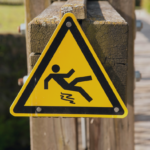Top 5 Safety Hazards on a Worksite
Whether the worksite is in a factory environment or at an outdoor construction site, the manufacturing industry comes with health and safety hazards. Ensuring worker health and safety is critical to the well-being of not only employees but also the company itself in terms of maintaining long-term productivity and profitabillity. According to the Occupational Safety and Health Administration (OSHA), the National Safety Council estimated that work-related deaths and injuries cost the nation, employers, and individuals $171 billion in 2019.
A recent Bureau of Labor Statistics report (BLS) found that a worker died every 101 minutes from a work-related injury in 2021. In addition, employers reported 2.6 million injury and illness cases in 2021.
While each specific industry has its own specialized set of risks, there are many common hazards shared by them all. Let’s take a look at five of these hazards:
- Slips, Trips, and Falls: Fall protection was the most commonly cited OSHA violation of 2020, and it’s been the #1 violation for the past 10 years. Lack of fall protection and proper training contributes to dangerous falls, which are the leading cause of death in the construction industry. OSHA’s Fall Protection standard outlines a variety of potential violations, which include using the wrong type of fall protection and failing to keep floors in work areas in a clean, and if possible, dry condition.
- Chemical Exposure: According to OSHA estimates, about 32 million workers are potentially exposed to hazardous chemicals in the workplace each year. Chemical hazards can take the form of liquids, gases, vapors, fumes, and particulate materials. These dangerous chemicals include acids, pesticides, carbon monoxide, flammable liquids, welding fumes, silica dust, and fiberglass fibers. One of the most important measures that an employer can take to safeguard workers against exposure is developing, implementing, and maintaining a comprehensive hazard communication program including provisions for container labeling, collection and availability of material safety data sheets, and employee training.
- Powered Industrial Trucks: Injuries involving powered industrial trucks (forklifts or lift trucks) is one of the top manufacturing hazards in industry. A 2018 OSHA report estimates that 35,000 serious injuries and 62,000 non-serious injuries involving forklifts occur annually, with the top causes of fatalities resulting from tipping and pedestrians being struck by moving forklifts. Proper operator training/retraining and establishment of proper forklift operation procedures could reduce accidents by 70 percent.
- Electrical Hazards: According to the Electrical Safety Foundation International (ESFI), while electrical fatalities in 2020 decreased by 24% from the previous year, nonfatal electrical injuries involving days away from work totaled 2,220 in 2020, a 17% increase over 2019. The riskiest industries are construction and extraction (44%), installation, maintenance, and repair (20%), Building and Grounds Cleaning & Maintenance (13%), Transportations & Material Moving (6%), and Management (5%).
- Ergonomic: Ergonomic related musculoskeletal disorders (MSDs) account for 33% of all employee injury and illness cases. These occur when the body uses muscles, tendons, and ligaments to perform tasks, often in awkward positions or in repetitive activities which, over time, can create pain and injury. Overexertion and repetitive motion are the primary causes of these injuries, which may include pinched nerves, carpal or tarsal tunnel syndrome, and other connective tissue disorders. A BLS report notes that in 2018 there were 900,380 Days Away From Work cases in the U.S. private sector, of which 30% were MSD cases.
Minimizing or even eliminating workplace hazards begins with awareness. With preventative measures and quality worker training, preventing incidents from ever happening can increase productivity, reduce days off, and save lives.



